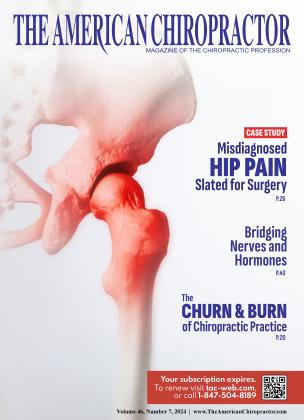Chiropractic and Medical CE: Not So Uncommon Anymore
By William Owens, DC, DAAMLP
In recent years, the fields of chiropractic and medicine have increasingly recognized the mutual benefits of collaboration, particularly in the realm of continuing education (CE). This partnership has catalyzed a surge in co-credentialed courses, marking a significant shift toward an integrative approach to healthcare education.
The Accreditation Council for Continuing Medical Education (ACCME) played a pivotal role in this integration. As the body responsible for accrediting institutions that offer CE to physicians and healthcare teams, ACCME ensures that educational programs meet rigorous standards designed to be relevant, effective, and independent. By setting these standards, ACCME accreditation serves as a hallmark of quality, signaling to healthcare professionals that the content is educational, unbiased, and evidence based.
The trend toward co-credentialing courses — accrediting a single course for both chiropractic and medical CE credits — has seen substantial growth. This movement is not merely an administrative change; it reflects a deeper recognition of the value of interdisciplinary learning. Shared educational experiences enable chiropractors and medical doctors to learn from one another, fostering a more unified understanding of patient care, particularly in spine health.
Such collaboration in education is critical for the advancement of spine care in the United States. Spinal disorders are a leading cause of disability and a significant public health challenge. Effective management of these conditions often requires a multifaceted approach that benefits from the expertise of chiropractors, with their specialized knowledge of biomechanics, spinal manipulation, and musculoskeletal health, and medical doctors, with their broad understanding of systemic and pharmacological treatments.
It has been my privilege to be at the forefront of this trend as CEO of the National Spine Management Group and through my faculty position at the University of Buffalo Jacobs School of Medicine. By initiating and supporting the dual credentialing of coursework, we have set a precedent that promotes a more inclusive educational framework. This effort bridges gaps between distinct healthcare disciplines and enhances the collective competence of spine care providers.
As we look to the future of chiropractic and medical education, the call to action is clear. Every chiropractic organization in the country should strive for dual credentialing of their courses. This is not a superficial alliance; it is a commitment to pursuing the highest standards of care for our patients. Learning together ensures that chiropractors and medical practitioners are studying at the same level of rigor, are exposed to the latest research and treatment modalities, and are encouraged to speak a common language of care.
This commitment to shared education can transform the landscape of spine care. It enables practitioners to offer more comprehensive and cohesive treatment plans and fosters an environment where collaborative practice is the norm rather than the exception. In a health system that often compartmentalizes care, dual-credentialed continuing education serves as a beacon for integrated practice, leading to improved outcomes for patients suffering from spinal ailments.
The movement toward interdisciplinary continuing education is more than a trend; it is a necessity for the evolution of health care. With spine-related conditions persisting as a significant challenge, the need for cohesive education and integrated care strategies has never been more urgent. As we continue to foster this collaborative educational environment, we enhance the quality of care available and affirm our dedication to lifelong learning and professional development at the core of the chiropractic and medical professions.
In conclusion, the harmonization of chiropractic and medical continuing education symbolizes a new era in health care where knowledge is shared, expertise is broadened, and patient care is unequivocally enhanced. The National Spine Management Group remains dedicated to championing this cause, urging every chiropractic organization to embrace dual credentialing and the enriched learning opportunities it presents. As we work toward this goal, we not only elevate the standard of spine care in the United States but also exemplify the profound benefits of unity in the healthcare community.
Dr. William Owens Jr. is currently CE of National Spine Management Group, an evidence-based clinical education company with locations in Buffalo, New York, and Lehi, Utah. Dr. Owens is the clinical director of a fellowship in spinal biomechanics and trauma, as well as a residency program in spine management. He is in private practice in Buffalo, New York, and his practice employs four doctors of chiropractic and three doctors of physical therapy. Additionally, Dr. Owens holds faculty positions in the Department of Family Medicine at the University of Buffalo Jacobs School of Medicine and Cleveland University Kansas City College of Chiropractic.
 View Full Issue
View Full Issue






